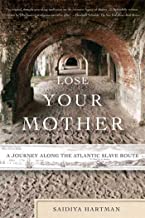Lose Your Mother: A Journey Along the Atlantic Slave Route by Saidiya Hartman 2007
Hartman, a Professor at Columbia and a MacArthur awardee, has written a powerful book about living in today’s America as a Black woman, continuing to face the “afterlife of slavery”. Hartman wrote this book after spending a year in Ghana as a Fulbright Fellow, coming away with the sense of not belonging, of being a stranger in Africa. Her writing is filled with terms like ‘the other’, dispossession, isolation, severance, extraneous, and an identity produced by negation. Not feeling welcomed or at home in Ghana, she reflected back upon the ‘afterlife of slavery’ in the U.S. and the feeling that Blacks are still ‘the other’ in American society—excluded, attacked, and ultimately denied equal citizenship.
The book has two interwoven stories. The first is a detailed historical, scholarly examination of the Middle Passage, the movement of 12 million Africans across the Atlantic from the late 16th through the middle of the 19th Centuries. Since some historians estimate that as many as one in three of those bound for the Caribbean and the Americas died during captivity or transport, the number of Africans uprooted from their families, homes, and villages may be closer to 50-60 million, a number that beggars the imagination! The Portuguese, succeeded by the English, French, and Dutch were the masters of this trade, though Hartman makes clear that the actual capture and initial transport of the enslaved were done by fellow Africans, the royalty and merchant classes of the South pillaging and kidnapping and ultimately emptying the towns and villages of the north. Her descriptions of the inhuman conditions the enslaved were exposed to in captivity in places like the Elmina and Cape Coast castles and on the slaving ships crossing the Atlantic were difficult to read. Man’s inhumanity to man was too horribly evident. She exposes the ‘masters’ attempts to erase the enslaveds’ history. As the title indicates “if you know your history, you know where you come from. To lose your mother was to be denied your kin, country and identity. To lose your mother was to forget your past”.
The second half of the book focuses more directly on the lived afterlife of slavery for both today’s Africans and their distant relatives, America’s Blacks. She cites several quotes from the French philosopher Michel Foucault which struck me powerfully: He defined racism as ‘the social distribution of death; like an actuarial chart, it predicts who would thrive and who would not.” He also is quoted as saying: “There is only the iron hard of necessity shaking the dice-box of chance.” Hartman applies that statement to today’s America. In an example of how my current reading is opening my eyes to the impact of the systemic racism on today’s Black/White conflict, Hartman points out that the European slavers traded cowries for slaves. They exchanged worthless sea shells that were the valuable currency of African royalty and merchants, for slaves, one of the most valuable ‘capital’ investments of the time. The Europeans thus became enriched through the labor of the slaves while the Africans were left with worthless sea shells, the losers in the often-vicious game of capitalism. The gap between white and black wealth in today’s America was unfair from the beginning.
I read this book as part of a course which is being offered to 12 of us ‘old white folks who live in Cambridge’ by the gracious and brilliant Harvard Senior Lecturer, Caroline Light, the Director of undergraduate studies in the Program in Women, Gender, and Sexuality Studies. Professor Light is teaching us about the roots of critical race theory and the impact of racism on Blacks in America today from an historical perspective. We are most fortunate to have her guidance and wisdom.



